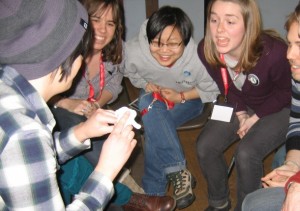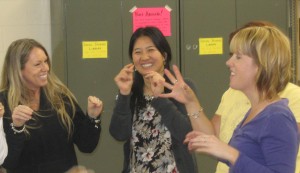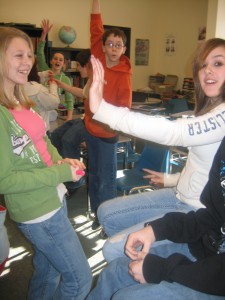Sep 07, 2012 Another Brain-Friendly Strategy for Blending Community Building, Academic Review and Social-Emotional Learning: Charades Race
This time of year many of us are returning to the classroom or kicking off training programs. We often start by facilitating community/team building activities with groups to build positive rapport and buy in as they start the semester, training or course. As the program or school year progresses the pressure to reinforce and assess academic content increases and sometimes the focus on group work, social skills development and team-building goals gets moved to the “back burner.” I encourage educators to think of blending together academic, social-emotional, and group building/school climate goals throughout their whole curriculum or program.
 Interactive approaches to practicing, recalling, reviewing and discussing academic material increase engagement. According to new research on the brain and learning using a variety of teaching and review methods that involve multiple senses helps learners retain and recall information by promoting multiple “learning pathways” for storing and accessing information (Willis, 2006, 2011).
Interactive approaches to practicing, recalling, reviewing and discussing academic material increase engagement. According to new research on the brain and learning using a variety of teaching and review methods that involve multiple senses helps learners retain and recall information by promoting multiple “learning pathways” for storing and accessing information (Willis, 2006, 2011).
In past articles I have offered some of my favorite group building, communication and problem-solving activities that double as “brain-friendly” interactive approaches to review and reinforce academic content. They also make great formative assessments to check learners understanding of content. These include “Have You Ever” Upcycled as “Anyone Who”, Handshake Mingle and Play Dough Pictionary. Another of my favorites is “Charades Race”.
 “Charades Race” is just as it sounds. It is a team relay race involving participants in small teams taking turns as actors to help their teammates understand a list of words or concepts. Because this version of charades is played as a relay race with multiple groups simultaneously playing many find it less intimidating than traditional charades. There is no one person in the “spotlight” by themselves in front of the whole group and everyone has a choice about whether they want to be an actor for their team.
“Charades Race” is just as it sounds. It is a team relay race involving participants in small teams taking turns as actors to help their teammates understand a list of words or concepts. Because this version of charades is played as a relay race with multiple groups simultaneously playing many find it less intimidating than traditional charades. There is no one person in the “spotlight” by themselves in front of the whole group and everyone has a choice about whether they want to be an actor for their team.
For years I have used this as a playful way to practice teamwork, creativity, communication, and other social skills with groups of all kinds. I adapted it as an academic content review activity while working in the classroom with educators who are trying to differentiate their instruction and review methods. I discovered this game is not only a great way to review content, it can be used to reflect upon common group experiences. I have used charades race to explore and review a variety of academic topics from geography, science terms, historical events, feelings expressions in guidance group and even to review a book in language arts. I have also used it as a reflective activity to celebrate a group’s accomplishments after a week of staff training.
Directions:
• Divide participants into groupings of 5-6 using the partner “consensus” method (see April 2010 post).
• Come up with a list of at least as many concepts or words as there are members on each team. Some teams might have to send an actor up twice and some team members might choose not to be actors and send another person up in their place (this built in choice is part of what makes the game work, though most people choose to act).
• I often give the group some time to strategize. For example, if one participant knows charades signs they can teach them to their teammates for better communication during the game.
• Have the first actors come up for their word. After their teammates guess it they send the next teammate up to get the next word. Make sure to have them tell you which word they guessed last so that you can better keep track of what word each team is currently on.
• The first team to get through the whole list wins.
• It is fun to have the teams show how they guessed/acted out some of the more difficult concepts. Most groups spontaneously start asking and sharing with the other teams about how they communicated more abstract ideas leading to some great reflective discussions around the content, communication, and creativity.
Enhance learning and ownership by giving participants the opportunity to lead the game. You can ask if there are students/participants in the group who feel like they have enough knowledge of the concepts to come up with a review list for the game. This works well when you play a second round and they understand the game. The teachers I work with are often surprised by who volunteers (a number of times it has been a student who doesn’t usually raise their hand in class and we have found out through the game that they had mastery of content).
 In one middle school classroom a teacher asked me to find an interactive way to initiate a class discussion about the book students were reading called The Giver. I decided to try Charades Race. Since I was unfamiliar with the book I asked students to each write a person, place or thing from the book and hand their paper to the front. Their teacher and I took a moment to choose the concepts while asking students plan with their team. I was so impressed with their interest and buy in and ability to communicate abstract concepts from the book. The best part was when the game ended and they started a reflective discussion on their own- asking other teams how they acted out and guessed the more difficult concepts leading to an in depth discussion around their reactions to the book. Their teacher reported back to me that students who had not been keeping up with their reading prior to our game were suddenly showing an interest in the book.
In one middle school classroom a teacher asked me to find an interactive way to initiate a class discussion about the book students were reading called The Giver. I decided to try Charades Race. Since I was unfamiliar with the book I asked students to each write a person, place or thing from the book and hand their paper to the front. Their teacher and I took a moment to choose the concepts while asking students plan with their team. I was so impressed with their interest and buy in and ability to communicate abstract concepts from the book. The best part was when the game ended and they started a reflective discussion on their own- asking other teams how they acted out and guessed the more difficult concepts leading to an in depth discussion around their reactions to the book. Their teacher reported back to me that students who had not been keeping up with their reading prior to our game were suddenly showing an interest in the book.
When working with a camp staff who were finishing up a week long of staff training I used Charades Race as a way to reflect on their week together. A few staff members led the game using content from their trainings, camp traditions, and fun moments the group had together during the week. It was a playful, uplifting way to end the training. As with the classroom experiences, the camp director received valuable feedback on what participants were taking away from the training experience.
In upcoming posts I will offer more of my favorite activities that double as community building and academic review. Reflect on your own personal favorites. I bet there is a way to adapt them to fit multiple purposes.
References and Resources:
This activity was inspired by a charades relay game called FEACH I learned many years from my colleague Karl Rohnke who credits his co-author of Quicksilver Steve Butler for inventing the “Fast Foods, Electrical Appliances and Comic Book Heroes (FEACH)” pantomime game that is popular in the adventure education field.
Brain Research Resources:
Understanding by Design Meets Neuroscience: Teaching to the Test and Rote Memory Tests as Measurement of Achievement are Not Neuro-logical for Successful, Joyful, Learning 2011 Learning and the Brain Conference Boston. www.radteach.com
Willis, Judy. (2006). Research-Based Strategies to Ignite Student Learning. Alexandria, VA:
Wang, Sam and Aamodt, Sandra. Welcome to Your Brain (2008)



No Comments